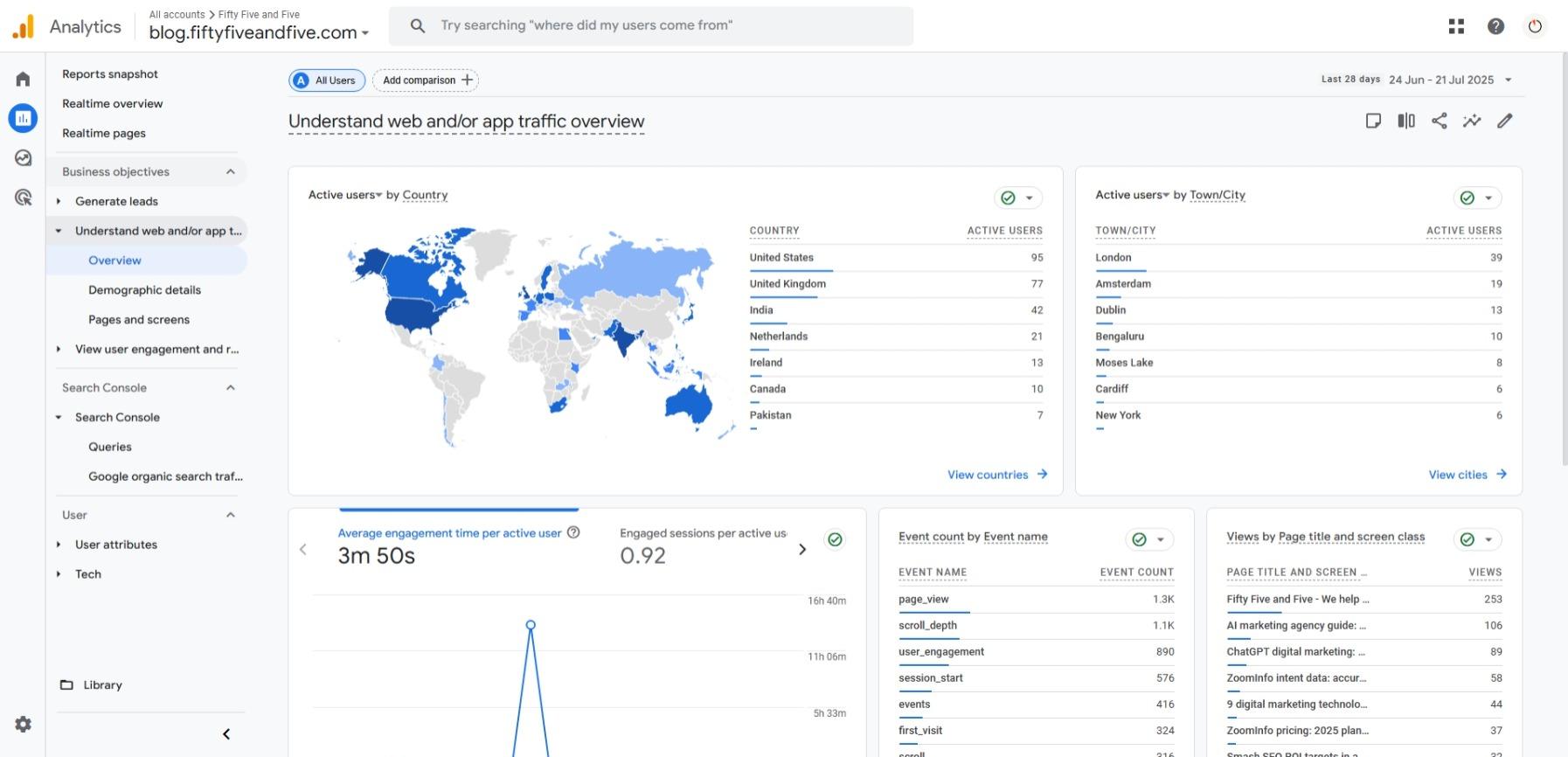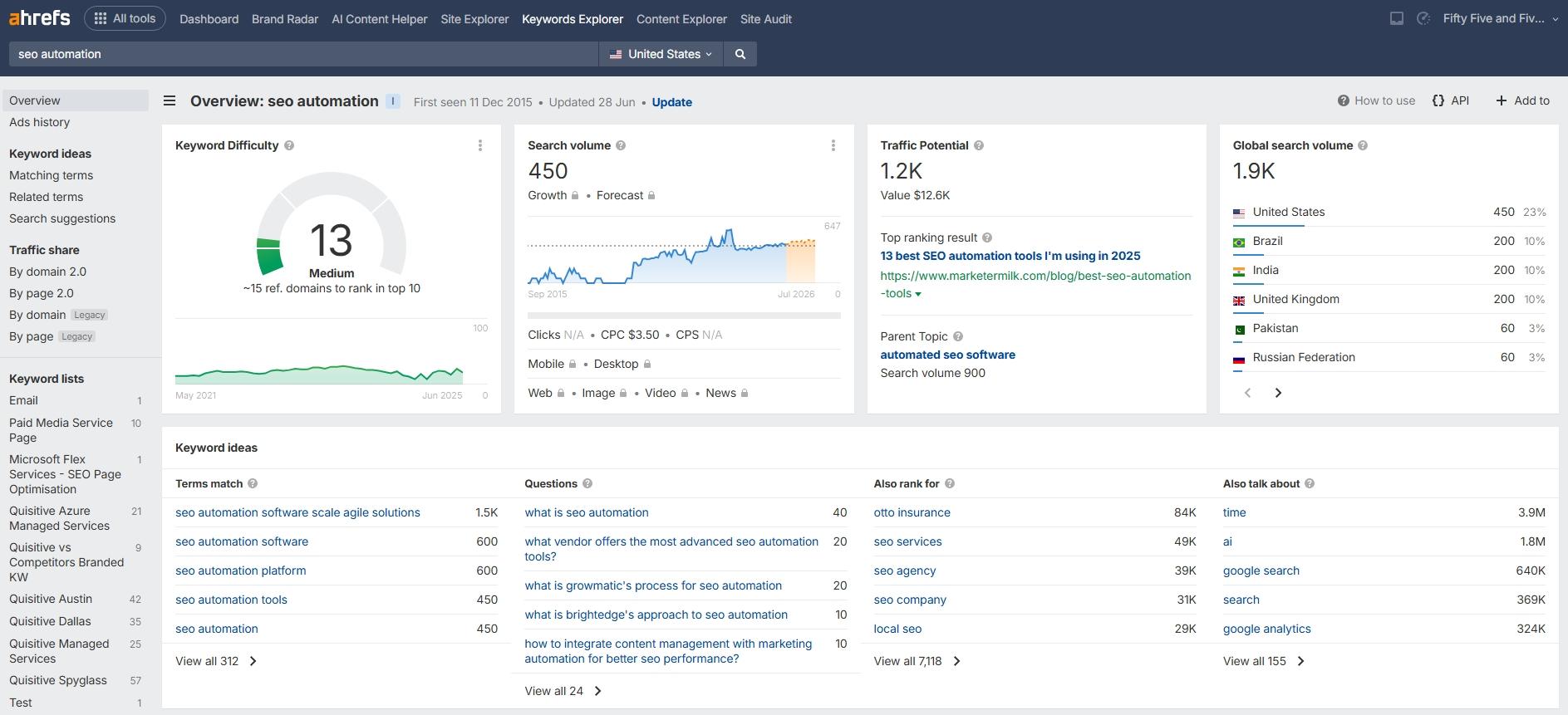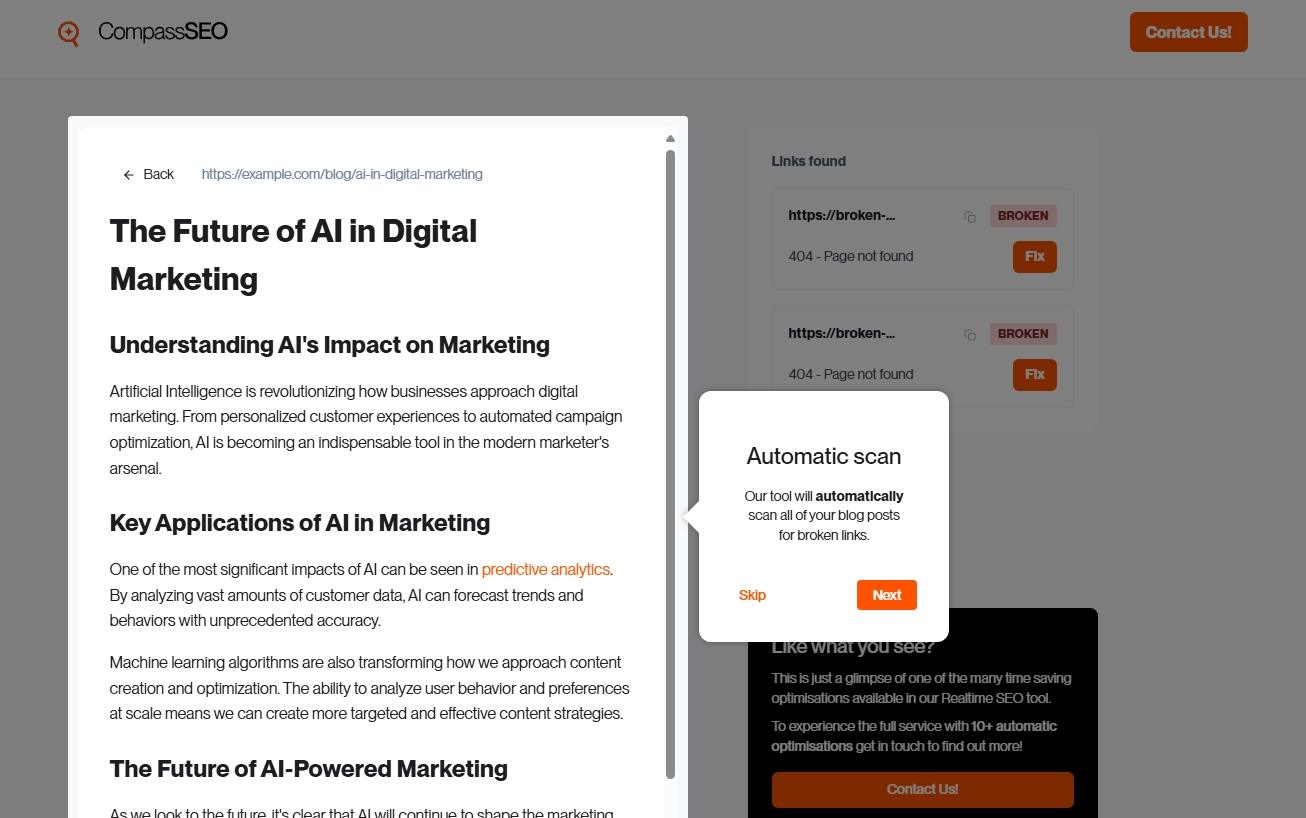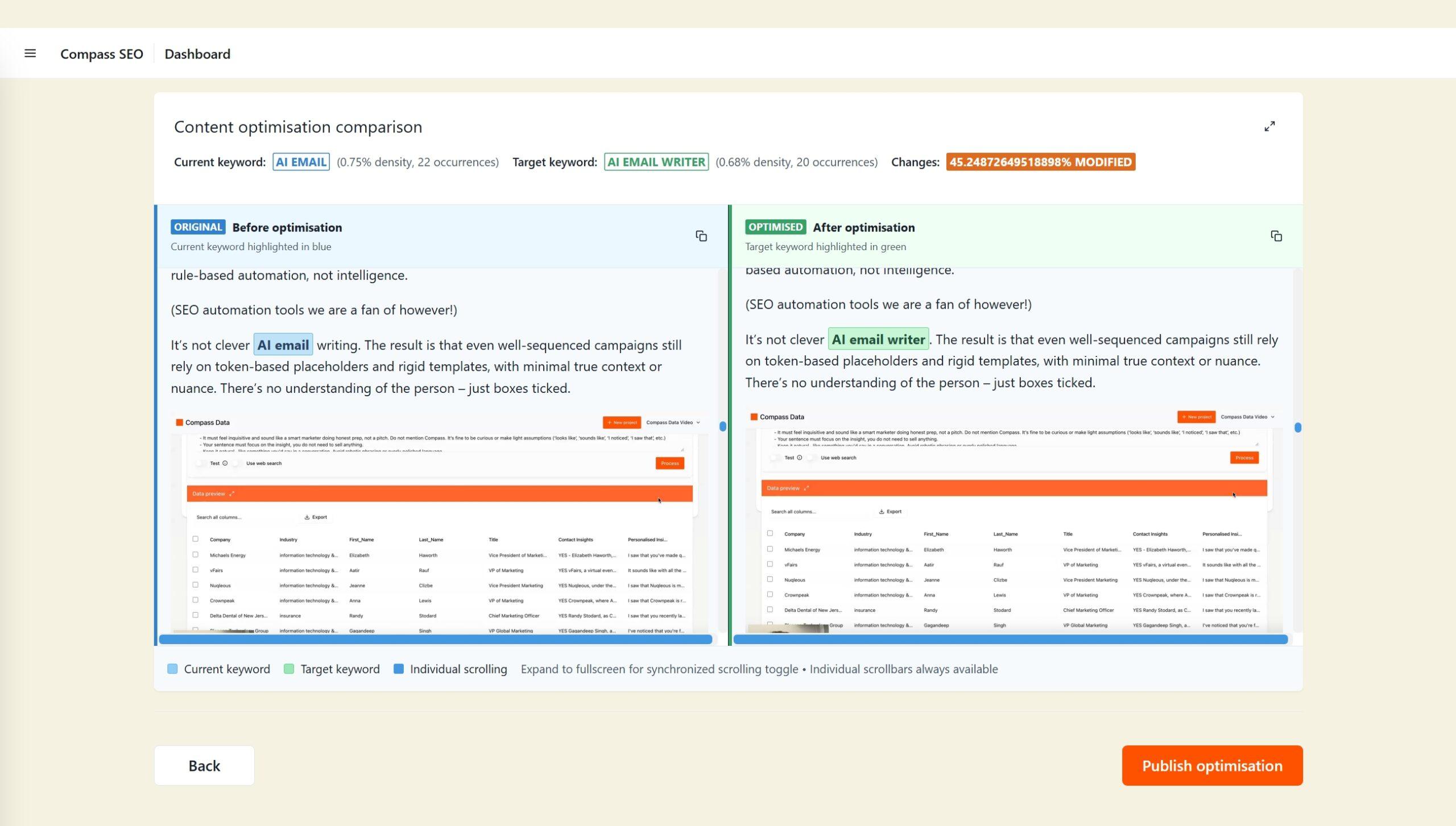SEO automation in 2025: Because you’ve got many better things to do
Last edited: 25nd July 2025 - Written by Megan Rudd
What is SEO automation?
SEO automation refers to leveraging software tools to manage aspects of search engine optimisation that do not require direct human intervention (later in this post we will summarise the best SEO automation tools 2025). However, it's important to understand that automation is far more than just a means of saving precious time. It is also about keeping pace with search engine updates and the emergence of new competitors is critical.
Your content risks becoming outdated without timely oversight, and many in-house teams find it challenging to adapt quickly. This is where automation becomes invaluable, bridging that responsiveness gap.
You may have utilised SEO content automation without even realising it. For example, configuring a scheduled crawl in Screaming Frog qualifies as automation. Similarly, generating a weekly dashboard report via GA4 is a common practice. What is shifting now is not merely the tasks we automate but the intelligence and sophistication behind these techniques.
Today’s SEO automation capabilities extend far beyond simplistic tasks; they encompass innovative solutions such as real-time meta description optimisation, comprehensive keyword tracking across numerous pages, and even automated scripts that monitor site changes and initiate immediate corrective actions for content freshness SEO. Moreover, AI technologies are evolving to cluster keywords based on meaning rather than mere textual matches, allowing for a more nuanced understanding of search intent.
This transition signifies a movement toward not just automating tasks but also enhancing decision-making efficiency, moving the field of SEO into a new, intelligent phase.
Automation today can mean:
-
Tools that rewrite your meta descriptions in real time
-
Platforms that track every keyword movement across thousands of pages
-
Scripts that monitor site changes and trigger SEO fixes instantly
-
AI models that cluster keywords by meaning, not just match
We’re no longer just automating “tasks.” We’re starting to automate judgement. Not perfectly, but fast enough that it’s useful.
The old model is manual SEO
Manual SEO is slow. It’s built around checklists and reviews. You write a blog, then optimise it. You notice a drop in rankings, then investigate. You fix broken links once someone complains. It works. But it’s reactive. And over time, you spend more energy keeping the engine running than moving forward.
The new model is what we call SEO in real time
You don’t wait for rankings to drop, you spot changes as they happen. You don’t guess what to optimise, you know, because the data updates constantly. That’s the real promise of SEO automation tools in 2025: not just speed, but timing.
Most teams aren’t there yet. They’re somewhere in the middle. Maybe they’ve automated audits. Maybe they use AI for content briefs. Maybe they’re testing programmatic pages. This is all good, this is progress.
What matters is this: the more you automate the routine parts of SEO (automation SEO), the more time you free up for work that actually drives traffic (like SXO), strategy, insight, and website engagement that says something real. Automation isn’t the strategy. But it’s how you make strategy possible.
Five clear benefits to SEO automation
It's worth repeating, most SEO teams aren’t short on knowledge. They’re short on time. The tools have improved. The search landscape hasn’t gotten any simpler. You still have to deal with the same messy list: keyword gaps, technical debt, outdated content, unexplained traffic drops.
And when you're running a site with hundreds—or thousands—of pages, manual SEO just doesn’t scale.
If you need to build a business case for your boss to invest in some new tech, or even just the time for to investigate this word then here are 5 automation SEO benefits we think are compelling.
1. Time savings where it counts
Fixing metadata. Checking for indexing issues. Tasks that happen daily, but no one sees, unless something breaks.
These things need to be done. But they don’t need to be done by hand.
When you automate them, you free up hours, even days, that can go to better use: strategy, content planning, testing, outreach.
Fixing metadata, spotting and fixing broken links., and checking for indexing issues are essential tasks that occur daily in the background of SEO management. Often unnoticed, these critical tasks can cause significant disruptions if neglected.
For instance, a single broken link can lead to a 404 error page, potentially resulting in a 30% decrease in user engagement and lost revenue (that's what we saw with one recent client). These processes do not have to be handled manually!
By automating these functions, businesses can save countless hours - potentially freeing up to two weeks of staff time each quarter (we tasked one of our clients to crunch a number and got this). This time can then be redirected towards more strategic initiatives such as comprehensive content planning, data-driven testing, and effective outreach campaigns. The automation of repetitive SEO tasks not only enhances operational efficiency but also empowers teams to focus on projects that drive growth and innovation (like website engagement).
2. Faster response to change
Google’s algorithm updates constantly. Competitor rankings shift daily. Search trends move fast. Manual SEO means you’re always reacting. Automation means you can keep up or get ahead.
An automated SEO stack flags changes as they happen:
-
Rankings drop → metadata is refreshed
-
Broken links → auto-redirected
-
Keyword intent shifts → new content triggered
- Content dated → Update content freshness for SEO
You don’t fall behind because you’re not waiting on a monthly audit to tell you something broke three weeks ago. You are doing SEO content automation.
3. Less room for human error
SEO requires meticulous attention to detail, and that repetition can lead to errors. For instance, a member of our team once overlooked an important redirect during a site update, which caused (luckily) a small amount of traffic loss. This kind of mistake can easily happen when managing multiple tasks manually, adding to the already high-pressure environment.
However, with automation, you reduce the risk of human oversight. There's no need to remember to run reports or update specific fields; these tasks occur seamlessly in the background. As a result, you achieve greater consistency and can spend less time on immediate issues, focusing instead on strategic growth.
4. Smarter prioritisation
Most SEO work gets done late. After the dev sprint. After the blog goes live. After someone notices a problem.
With the right automation SEO, you shift from post-mortem to proactive. You catch issues before they impact rankings. You optimise content before it slips out of relevance. You get ahead of competitor moves instead of reacting to them.
5. Better use of budget and people
Enterprise teams don’t always lack budget, they lack focus.
If you’re paying people to do work a machine could do faster and more accurately, you’re wasting budget. If you’re drowning in reports but not taking action, you’re wasting time.
Automation lets your team move up the value chain (like thinking about how UI, UX, SXO can help drive AI app traffic). Strategy. Innovation. Things that drive actual growth.
Up next: What exactly can you do in SEO content automation, and what should stay human?
SEO automation - A practical guide
So you came here for help. Let's do it. You can automate more than you think. But not everything.
This section breaks down the SEO tasks you can automate right now, where automation works best, and where you still need people to think and decide. It’s long for a reason. If you skip this step, you risk spending time and budget on automation that adds complexity instead of removing it.
Here’s the 7 critical tasks you should automate:
Task 1. Reporting and performance monitoring
This is usually the first thing teams automate. It makes sense. Manual reporting is slow and often pointless. You pull numbers, drop them into a slide deck, and no one acts on them. Ibn the past, I mean last weke, people set up automated dashboards with tools like Looker Studio, Ahrefs, or GA4. Track changes in traffic, rankings, CTR, crawl errors and conversions without touching a spreadsheet. Good setups also include alerts so you're notified when things change.
Now this is OK. A decent report in Google Analytics 4 is a good thing, of course (check out our full list of SEO automation tools 2025 below). Check out our "Understand web and/or app traffic overview:
This report tells me stuff. I think. I still need to do a little hard work to get the insights. And I don't want to do this work, I have other things to do.
So I have a real pro tip fresh for July 22nd 2025:
Use ChatGPT Agent instead. This is a brand new product from OpenAI that control your computer. This is true SEO automation. Watch this:
Task 2. Technical SEO audits and fixes
Automation shines here. Technical SEO is built on rules. The meta tag is not there. The page is too slow. The redirect broke.
You can automate crawls, generate technical audit reports, and even push basic fixes through tools or scripts. Some tools identify errors and create the fix for you. A few can deploy them automatically, depending on your setup.
Tasks like this are ideal for automation:
-
Finding broken links
-
Spotting redirect chains
-
Checking page speed
-
Flagging indexing issues
-
Generating XML sitemaps
Consider utilising tools like Screaming Frog for scheduled crawls that automatically generate insights into crawl errors, page speed issues, and broken links. Sitebulb is another good option to assist in generating technical audit reports that highlight critical issues. You can automate link checks and push guides to maintain crawl efficiency without manually sifting through data, which is particularly useful during large migrations.
Task 3. Keyword research
Generative AI tools like ChatGPT are fantastic at understanding language, user intent, and content structure. They’re ideal for brainstorming keyword ideas, grouping by semantic similarity, and generating long‑tail variants - tasks that once took hours now take seconds. However, they don’t have access to live keyword metrics like search volume, CPC, difficulty scores, competitor rankings, or SERP insights — all critical for SEO validation.
In contrast, keyword platforms like Ahrefs, Moz and Semrush are built on real-world search data. They provide accurate metrics - volume estimates, difficulty scores, SERP analysis, content gap insights, and rank-tracking - making them indispensable for decision-making. These platforms are now adding AI-powered clustering and intent grouping on top of their data-rich foundations, which is much needed.
The sweet spot is AI + traditional tools. This is good SEO content automation. And you can get some automation benefits. Combining both approaches delivers the best results:
-
Start with generative AI
Use ChatGPT to surface broad and long-tail keyword ideas and sort them into thematically coherent clusters -
Validate with data tools
Run those keyword ideas through Ahrefs, Moz or Semrush to check search volume, difficulty, SERP features, ranking trends, and competitive gaps -
Refine and automate
Leverage AI clustering features in tools like Ahrefs — which can instantly cluster thousands of keywords based on SERP overlap — then adjust based on your strategic goals
Task 4. Content briefs and coming up with topics
There are tools that can read the top-ranking pages, extract the headings, identify missing angles, and build an outline. This speeds up briefing for writers and keeps your content aligned with what’s working in the SERP. Consider tools like Frase or MarketMuse to automatically extract headings and key topics from top-ranking pages. These tools read content across SERPs to determine aspects that are missing in your current articles, helping you generate better-aligned content briefs fast. A good practice is to supplement the automated insights with human judgment to ensure brand messaging and distinction remain intact.
This works well for large content teams, content agencies, or anyone managing a backlog of pages to improve. You still need someone to shape the idea, sense-check the suggestions, and inject a point of view. But the time spent on structure, links, headings, and examples gets cut down massively.
The best general purpose tool for content ideas and briefs is still ChatGPT, but you HAVE to customise it. With a proper customisation step you are using a generic tool that will give you generic results.
We have a Team account here at Fifty Five and Five. Within there we have a custom project, just for briefing work. This custom project has a set of markdown files that describes in detail who we speak, what we stand for, our content strategy, our clients, personas etc. Then we also have a custom prompt that is designed to mimic our manual (and custom) briefing process. Guess what? It works. People here riff back and forth and get results. It might sound easy. But actually tuning the content we gave it, the files and prompts, took about 3 years of our expertise. But now we have it, it really helps.
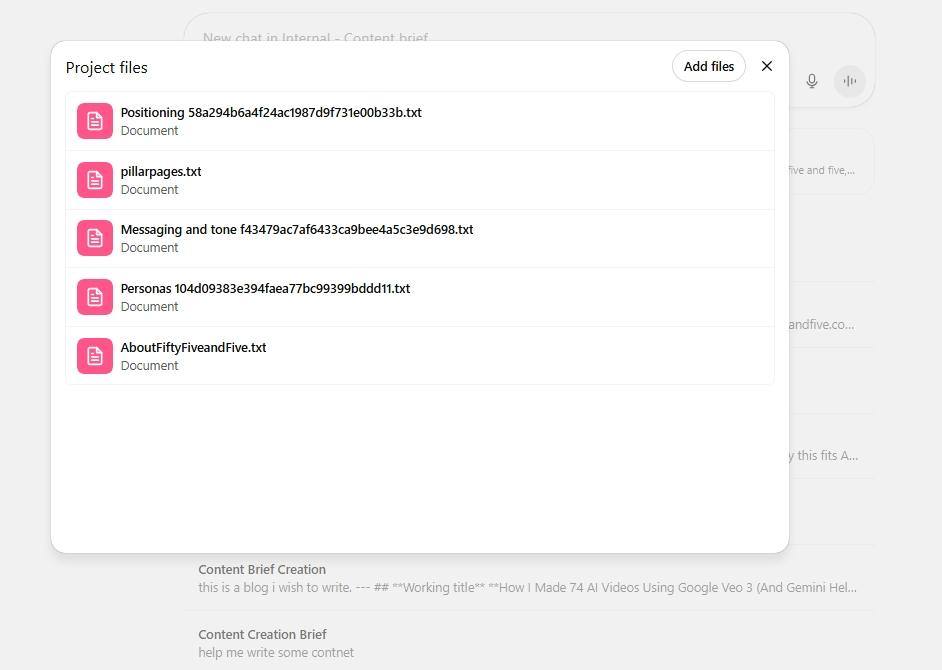
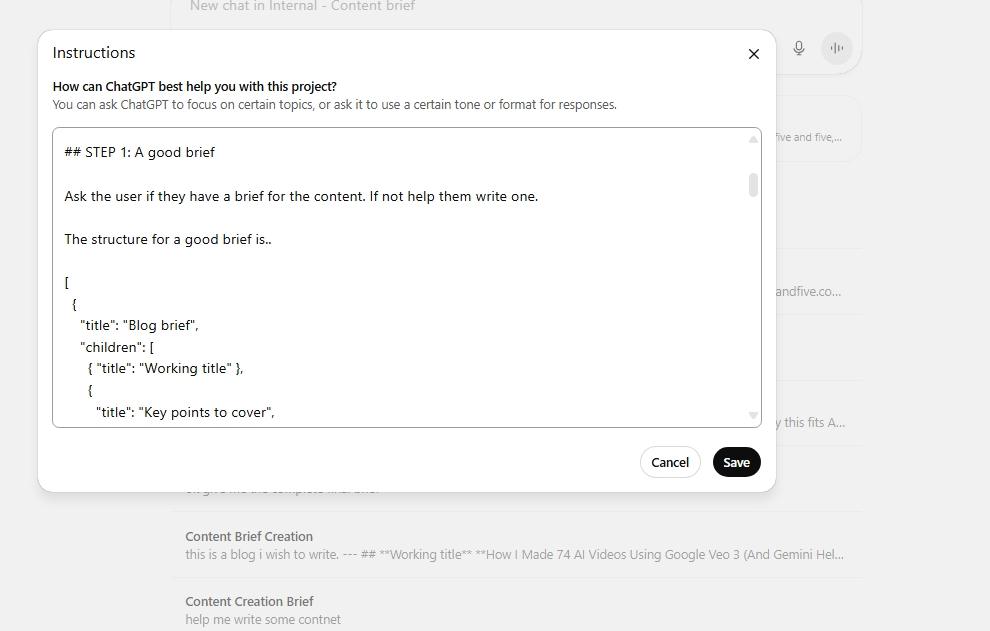
Task 5. Image and media optimisation
You can automatically:
-
Compress images
-
Add missing alt text
-
Rename files with target keywords
-
Detect large assets that are slowing down a page
This is basic stuff really, but essential. A lot of it isn't AI really, but really is automation. If you manage a large content library or a CMS with thousands of media files, doing this manually is not the way to go. We go a lot with WordPress so recommend ReSmush.it. It just works.
Task 6. Internal linking and redirects
Use tools like Link Whisper for internal linking automation, which recommends links based on content. Additionally, during site migrations or structural changes, set up automatic checks to identify broken links with tools like Ahrefs (our choice) or Moz. This keeps your site healthy with minimal oversight.
We are about to hit go-live on another option. Compass SEO is a platform we are building right now. It automatically optimisations posts without human intervention. This includes fixing broken links and adding internal links. It does both intelligently selecting appropriate and relevant content to replace old links with. We are really proud of it and if you'd like to join the waitlist ping me an email at chris.wright@fiftyfiveandfive.com.
Task 7. Automatic real time optimisation of content
Ok task seven contained a small plug for Compass SEO. This is the big one. Because it does so much more than links!
Most SEO automation tools still rely on periodic checks. Compass SEO takes a different approach. Built by Fifty Five and Five, it continuously monitors and updates your site in real time. Think of it as always-on SEO optimisation—without the guesswork.
Compass SEO automatically improves page titles, metadata, internal links, schema markup, and more, as your content evolves. It adapts your pages to reflect the latest ranking signals, search intent shifts, and keyword trends—minute by minute. There’s no waiting around for monthly audits or long spreadsheets of recommendations.
Because Compass is AI-native, it doesn’t just spot issues, it fixes them. It acts as your SEO analyst, strategist, and developer—rolled into one. That means your team can spend less time chasing rankings and more time producing content that converts.
We are making Compass SEO available to customers exclusively through our Real-time SEO managed service. It is really easy, anyone on a SEO retainer at Fifty Five and Five generally gets a set number of days a month of work from our team. Now that Compass SEO automates all of the 'SEO admin' the teams time is free to work on much higher value tasks. Some love to see the tool itself, other just want to make the most of working closely with the team on SEO strategy, content, or working out how we get them in these pesky AI overviews! Find out more about Real-time SEO.
We built Compass SEO to eliminate the lag between insight and implementation. It’s the SEO engine we wish we’d always had.

"The real benefit of automated SEO isn’t just speed. It’s consistency. It means we’re not waiting for a quarterly audit to fix things, we’re catching issues as they happen. We’ve got AI handling the repetitive stuff, so our team can focus on strategy, content, and uncovering real opportunities. That shift changes how you work.
Search engines have started downranking low-value AI content. That’s why we combine AI-driven optimisation with human oversight. And we use tools to ensure our content passes quality checks and stays valuable to readers, and visible in search."
Owen Steer, Senior Marketing Exec @ FFF
SEO that works while you sleep
Real-time SEO is designed for teams who don’t have time to chase every broken link or refresh old copy every month.
We run it. Our Compass SEO platform powers it. You get the results.
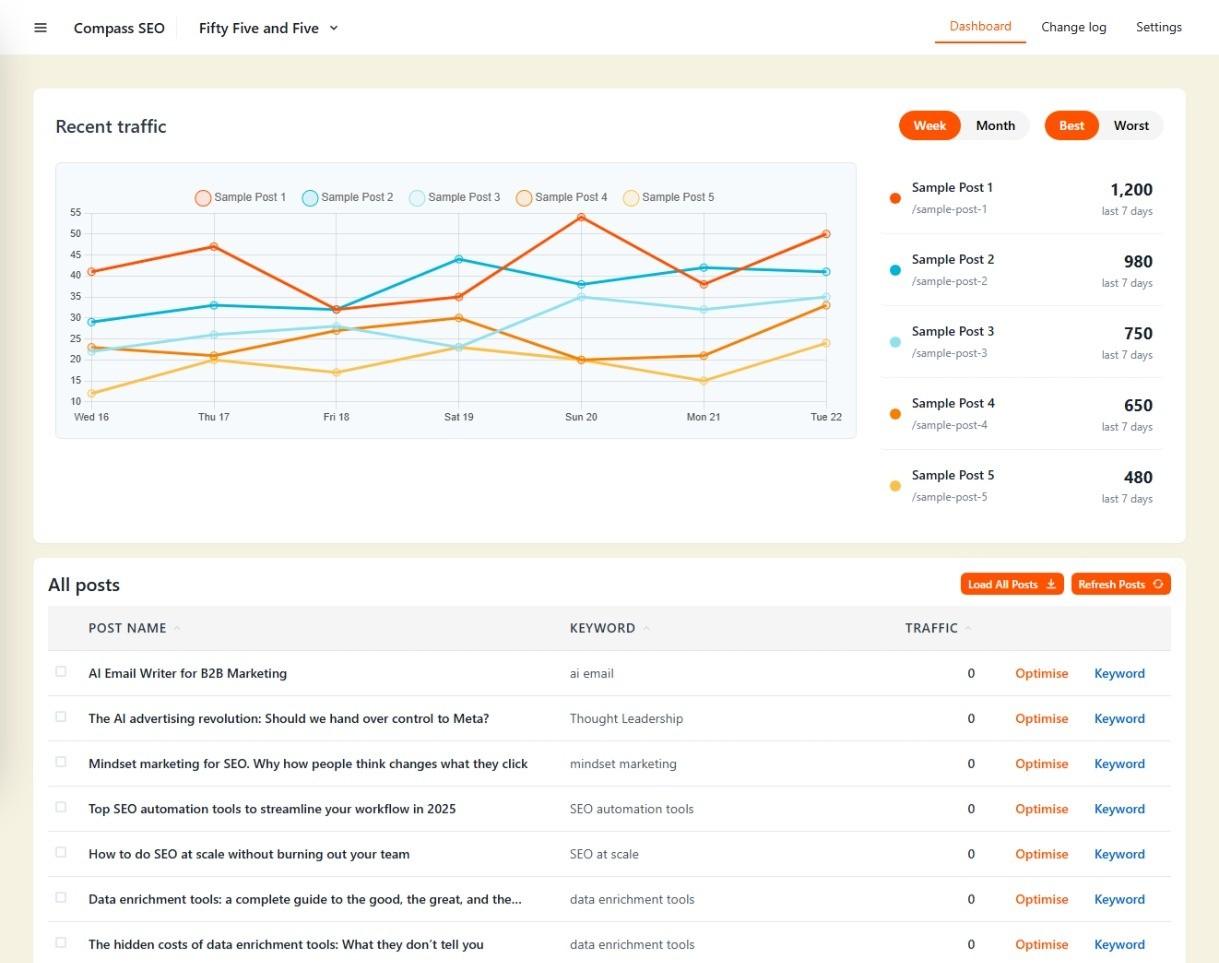
What other SEO content automation guides miss: automation isn’t a strategy
You’ll find hundreds of guides on SEO automation. Most of them are lists. Tools to try. Features to enable. Settings to tweak. What they leave out is the hard part: making it work.
Because automating SEO doesn’t solve SEO. It just changes the shape of the work. And if you don’t have a strategy behind it, you’ll end up with faster execution of bad decisions. That’s the real risk.
- You automate metadata updates but use the wrong keywords.
- You rewrite content but lose your voice.
- You fix broken links but ignore why the page dropped in the first place.
That’s not improvement. That’s noise.
Tools don’t think. They follow instructions.
Most automation runs on rules you set or AI models you prompt. The tools don’t know your business. They don’t know your product. They don’t know your customers. Take our ChatGPT example above. We use a custom project to create briefs. But the hard work is in the prompts and context we give the too.
Tools can’t tell if your site is optimised for the right audience. Or if your messaging aligns with your brand. Or if a competitor just overtook your category. That’s still your job. Or your team’s. Or your agency’s.
Automation works best when it’s not the goal
The goal is better performance. More relevant traffic. More useful content. Better site health. More consistent growth. Automation helps you get there. But it can’t decide where you’re going.
That’s why the most effective SEO setups use a mix:
-
Automation to do the repetitive work and AI to adapt at scale
-
People to shape strategy, set priorities, and make judgement calls
It’s not either-or. It’s both.
And it’s where Real-time SEO comes in. Because reacting once a quarter is too slow. And reacting to the wrong signals is just expensive. We’ve spent years watching teams do SEO reactively. Chasing drops. Fixing the same issues every quarter. Reporting without outcomes.
That’s why we built Compass SEO, to automate what can be automated, and free up space for better decisions.
Automation isn’t the strategy. But it’s how you make the strategy work.
SEO automation tools comparison
We've mentioned a lot of SEO automation tools for 2025 in this guide. So here is a summary of what they do, and pros and cons.
| Tool | Primary function | Best for | Key automation features | Limitations |
|---|---|---|---|---|
| Google Analytics 4 | Web analytics platform for tracking and reporting on website traffic and user behaviour. | Basic performance monitoring and understanding user engagement. |
|
You still need to do "a little hard work to get the insights" from the raw data. Hint: Use ChatGPT Agent! |
| ChatGPT Agent | An AI agent from OpenAI that can control a computer to perform tasks based on prompts. | Truly hands-off operation of sdo many tasks! We looked at reporting and automated data analysis, as it can navigate platforms like GA4 on its own. |
|
A brand-new product, so capabilities and reliability may still be evolving. |
| Screaming Frog / Sitebulb | Desktop-based website crawlers for in-depth technical SEO audits. | Advanced SEOs conducting large-scale technical audits, finding broken links, and checking for crawl errors. |
|
Requires manual setup and configuration. They identify problems for a human to interpret and fix, rather than fixing them automatically. |
| Frase / MarketMuse | AI-powered tools for generating content briefs and optimising content structure. | Large content teams or agencies needing to quickly create SEO-focused content outlines. |
|
Human judgment is required to shape the final idea, inject a unique point of view, and ensure brand alignment. |
| ReSmush.it | A WordPress plugin for automatic image compression and optimisation. | WordPress site owners with large media libraries who need to improve page speed. |
|
A basic but essential tool focused solely on image compression. It's not an AI tool and doesn't handle other aspects of image SEO like alt text. |
| Link Whisper | A tool that automates internal link suggestions based on content relevance. | Site owners looking to improve their internal linking structure with minimal manual research. |
|
It only provides suggestions; a human needs to review and approve the links to ensure they are contextually appropriate. |
| Real-time SEO | An AI-powered, expert-led managed service for continuous, real-time site optimisation. | Enterprise teams and scaling businesses wanting automated fixes combined with strategic human oversight. |
|
Not a self-serve SaaS product. It's a fully managed service provided by the Fifty Five and Five agency. |
FAQs: SEO automation
What exactly is SEO automation, and how do we actually use it at Fifty Five and Five?
SEO automation means using software - like crawlers, AI scripts or integrations—to handle repetitive SEO tasks that don't need creative thinking.
How it looks in practice: we set up daily Screaming Frog crawls that flag broken links or missing metadata, then Compass SEO auto-generates fixes and queues them. We once spotted a redirect loop discovered mid‑night, applied a patch automatically, and prevented a noticeable 5% drop in organic traffic before the team even logged on.
Can SEO truly be fully automated, or are we kidding ourselves?
It can’t be completely hands‑free. Machines can fix broken links, update titles, compress images - but only humans add strategy, brand tone, or emotional intelligence.
What we do at Fifty Five and Five: Let Compass SEO handle the admin layer- automating metadata updates, internal links, schema tweaks- so our consultants focus on shaping content strategy, guiding authors, spotting new angles and making sure messaging fits the brand.
How does automation SEO differ from traditional SEO?
Traditional SEO is a scheduled, reactive process: monthly audits, spreadsheets, manual updates. Automation turns it into a live, proactive system.
That daily alert we see? It’s not a surprise- it’s a planned prompt. Automated systems pick up keyword shifts, metadata issues, and ranking drops in real-time, then take basic corrective actions instantly. That’s why we call it Real-time SEO - it’s monitoring, fixing, and adapting every hour rather than every quarter.
Is AI safe for SEO, or are we risking Google penalties?
Used correctly, AI is a powerful ally—great for clustering synonyms, updating metadata at scale, sniffing intent shifts.
But caution: Human review is essential. At Fifty Five and Five, each AI-generated snippet goes through a quality check: tone, brand alignment, and factual integrity. Only then does it go live. Tip: Always run a human-in-the-loop audit—AI shouldn’t publish unchecked.
How does our Real-time SEO service actually work?
It mixes AI-powered automation with human consulting:
-
Setup: We connect your site to Compass SEO and configure our monitoring stack
-
Monitor: 24/7 scans flag metadata issues, intent drift, broken links
-
Fix & update: Compass SEO applies bulk updates where safe
-
Human oversight: Our team reviews, sets strategic direction, works with you on bigger topics, content, audience research
-
Iterate: Cycle repeats daily, so your site evolves continuously
Is Real-time SEO just software? Or is it a service?
It’s a managed service, not just a platform you log into. There are a lot of SEO automaton tools in 2025. This is better. You get a service team who deploys Compass on your estate for SEO content automation - analysts and strategists who handle updates, interpret insights, and guide your broader SEO story, free from manual grunt work.
What results can you expect when using SEO automation?
-
Metadata updated before rankings actually drop
-
Internal links improved without manual scrubbing
-
Broken redirects fixed almost instantly
-
Content refreshed when intent changes
-
Team time freed up—clients tell us they reclaim 5+ hours/week for strategy (like website engagement work)
-
Case study: one client saw a 12% YoY uplift in organic traffic within two months. Compass fixed 350+ broken links, updated outdated metadata, and enabled a focus shift to round-two content.
How do we get started?
-
Book a call—we audit your setup and show quick win opportunities
-
Pilot—connect Compass to one site for a 30‑day test: we monitor, apply fixes, report
-
Roll out—scale it across multiple sites, integrate human review cycles
-
Refine—shift your team’s focus to content, strategy, performance reviews



